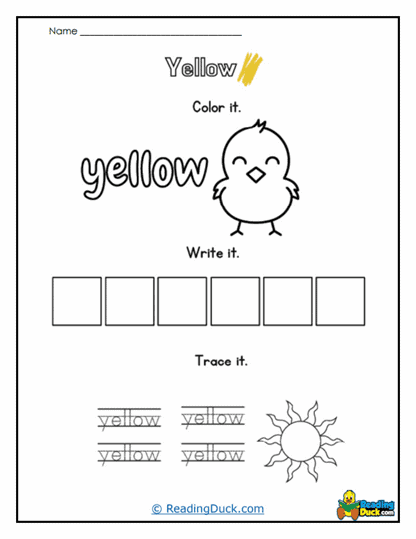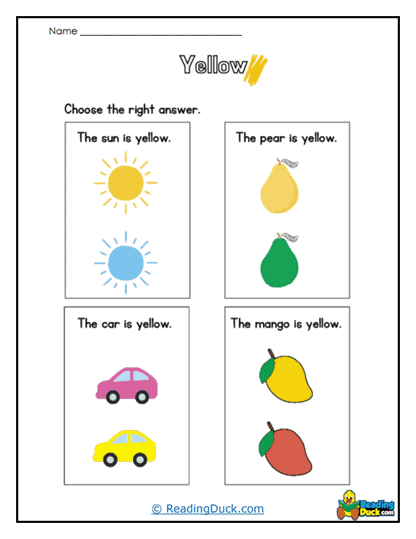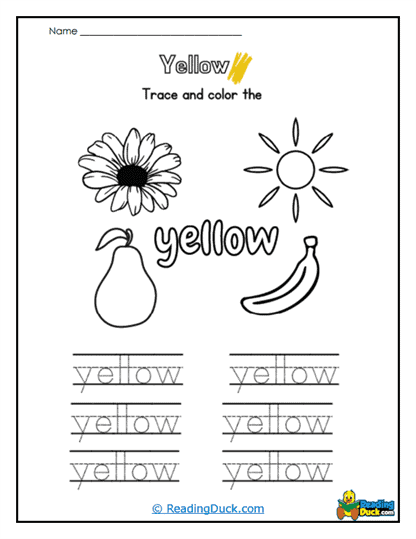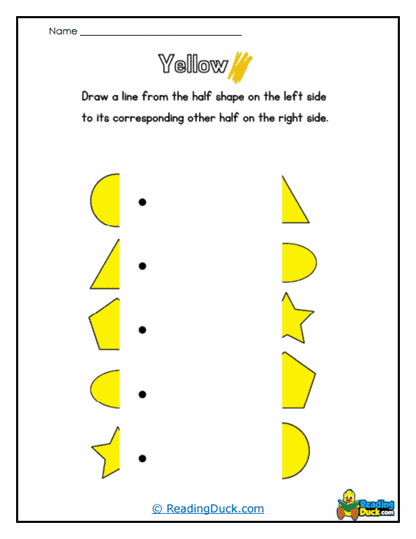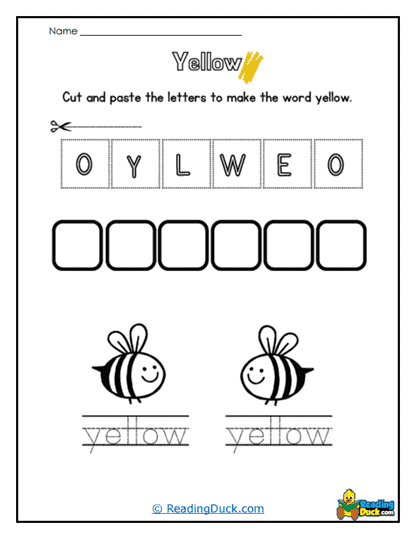Yellow Worksheets
About Our Color Yellow Worksheets
The worksheet set is an engaging collection of activities designed to introduce young learners to the color yellow. These worksheets are ideal for early childhood education, where recognizing colors is a foundational skill that promotes cognitive development and sensory engagement. By focusing on yellow, children can build familiarity with this vibrant color through interactive tasks, boosting their ability to identify and associate objects in their environment with specific colors.
These worksheets cater to preschool and kindergarten students, typically around the ages of 3 to 6, who are beginning to explore and understand the world around them. The worksheets incorporate various learning techniques, including tracing, coloring, circling, and matching exercises, making them suitable for hands-on and visual learners alike. The focus on "yellow" allows children to reinforce their color recognition skills while also developing fine motor skills through drawing and tracing.
The importance of these worksheets goes beyond mere color identification. They introduce children to the idea of categorizing and associating items based on shared characteristics, which is an essential skill for cognitive development. Through this focus on a single color, students learn to observe details, such as shades and tones, and apply that knowledge to new settings outside the classroom.
With clear and visually appealing graphics, the worksheets present a supportive learning environment that encourages students to learn at their own pace. Teachers and parents can incorporate these sheets into daily activities or thematic lessons on colors, making them a versatile resource for early education settings.
Types of Exercises
The color yellow worksheets include a wide variety of activities to keep children engaged and reinforce learning in multiple ways. One type of exercise found in these worksheets is tracing and writing. Students are encouraged to trace the word "yellow" to practice letter formation, an activity that enhances their handwriting skills and familiarizes them with both the color and its spelling.
Another engaging activity is color matching and object identification. Children are tasked with circling or coloring objects that are commonly yellow, such as a sun, duck, or flower. This activity helps children make connections between color and real-world objects, which aids in memory retention and builds their observation skills. By associating yellow with familiar items, children start understanding how colors function in their everyday lives.
Some worksheets offer puzzles and color-by-number activities to add an element of problem-solving and creativity. These exercises challenge children to use their understanding of color placement in an artistic and structured way, allowing them to reinforce what they've learned while expressing themselves creatively. By completing these tasks, students develop an understanding of colors in a more abstract and engaging format.
The worksheets also feature letter recognition activities, where students search for specific letters within a group to spell "yellow." These letter-finding exercises promote letter recognition, sequencing, and phonemic awareness in a playful and accessible way. Each type of activity has a unique purpose, contributing to a well-rounded approach to early learning and color education.
History of the Color Yellow
Yellow has a long and fascinating history that can be easily shared with young students in an age-appropriate way. Dating back to ancient civilizations, yellow has been a prominent color in art and symbolism. In Egyptian culture, yellow was associated with gold, a material they considered sacred and eternal, often used in the decoration of temples and treasures. Artists used yellow pigments in their paintings, which helped keep the color alive in historical records.
In nature, yellow is often associated with sunlight and warmth, which have symbolic meanings across cultures. For instance, many early societies associated yellow with life and growth due to its link with the sun. In ancient China, yellow was reserved for emperors and was a symbol of power and prosperity. This cultural history can introduce children to the idea that colors can have special meanings and associations that go beyond simple identification.
Yellow has also been a favorite among artists throughout history. Famous artists like Vincent van Gogh used yellow in many of their masterpieces, often to evoke warmth, energy, and optimism. This can be a fun connection to introduce to young students, showing how artists use colors to convey feelings and moods in their work. Sharing these fun facts can make learning about color history a lively part of classroom activities.
Over time, the meaning of yellow has evolved, yet it remains a popular color in art, fashion, and design. For students, learning about yellow's role in different cultures and its use in art can add an element of storytelling to their learning experience. By introducing these historical and cultural perspectives, teachers can make the color yellow more memorable and meaningful.
Emotions and Symbolism Associated with Yellow
Yellow is a color commonly associated with emotions like happiness, warmth, and positivity. It is often seen as an uplifting color that can brighten a person's mood, which makes it a favorite choice in children’s products, art, and designs. Teaching students about these associations can help them recognize how colors can influence feelings, adding a new dimension to their understanding of color.
In many cultures, yellow symbolizes energy and creativity, making it a popular color for children’s toys and learning materials. Because yellow is bright and attention-grabbing, it is often used in signage, safety gear, and important indicators, showing children how color can also play a functional role in their environment. Learning about this aspect can be both fun and informative for young students.
In addition to happiness, yellow can sometimes evoke caution, as seen in road signs and traffic lights. This dual nature of yellow as both a friendly and cautionary color is a unique trait that students can observe in everyday life. By learning about these associations, students can understand that colors have various meanings depending on context, an idea that broadens their cognitive understanding.
Yellow's associations with energy and optimism also make it a color that inspires activity and curiosity. These characteristics align well with the purpose of these worksheets, as they aim to engage young learners in exploring the color yellow in fun, positive ways. Teachers can use this symbolism to make lessons on color both emotional and meaningful for young students.
Color Mixing Outcomes with Yellow
The following table lists common color-mixing combinations with yellow and the resulting colors. This can help educators illustrate how colors interact and change, reinforcing students' understanding of primary and secondary colors:
| Colors Mixed | Resulting Color |
| Yellow + Red | Orange |
| Yellow + Blue | Green |
| Yellow + White | Light Yellow (light yellow) |
| Yellow + Black | Olive Green |
| Yellow + Purple | Muted Brown |
Teachers can use this table to conduct simple color-mixing experiments in class, giving students a hands-on experience with color blending. Through these experiments, students learn about primary colors and secondary colors, which builds foundational knowledge for future art projects and color theory. Engaging in color-mixing activities can be a memorable way for young students to observe how colors interact and transform.
